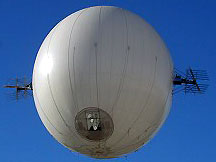Monday 31 December, 2007, 11:01 - Spectrum Management
Posted by Administrator
In a little known, sleepy backwater of the European Commission, moves are afoot to introduce a relatively obscure piece of legislation to allow mobile phones to be used on aircraft. There's nothing newsworthy in this you might think, Ryanair have already announced that they intend to install the equipment to allow their passengers to do just that and Air France have already begun trialling the service.Posted by Administrator
 The equipment concerned is basically a GSM base-station (working only in the GSM 1800 frequency band) installed inside the aircraft and connected back to the rest of the world via an external satellite link. However, the function of the equipment goes beyond just the role of making a connection between the mobiles on the plane - it must also stop the mobiles on the aircraft from connnecting with any terrestrial, ground based networks. Why is this important? It's argued that in order to allow mobile communication on aircraft, the power of the mobile transmitters must be kept to an absolute minimum to avoid interference to the avionics on the plane, which is a fairly sensible caveat to put in place. By forcing the phones on the plane to only connect with the on-board base-station their output power can be controlled and minimised, thereby minimising the risks concerned. The power needed for them to connect to a terrestrial network could be relatively high and could thus cause interfere with the avionics (there is some evidence to suggest this can happen) and this is why phones should normally be switched off during the flight (and especially during take-off and landing when pilots rely more heavily on the sensitive equipment in the cockpit).
The equipment concerned is basically a GSM base-station (working only in the GSM 1800 frequency band) installed inside the aircraft and connected back to the rest of the world via an external satellite link. However, the function of the equipment goes beyond just the role of making a connection between the mobiles on the plane - it must also stop the mobiles on the aircraft from connnecting with any terrestrial, ground based networks. Why is this important? It's argued that in order to allow mobile communication on aircraft, the power of the mobile transmitters must be kept to an absolute minimum to avoid interference to the avionics on the plane, which is a fairly sensible caveat to put in place. By forcing the phones on the plane to only connect with the on-board base-station their output power can be controlled and minimised, thereby minimising the risks concerned. The power needed for them to connect to a terrestrial network could be relatively high and could thus cause interfere with the avionics (there is some evidence to suggest this can happen) and this is why phones should normally be switched off during the flight (and especially during take-off and landing when pilots rely more heavily on the sensitive equipment in the cockpit). So how are the on-board base-stations going to stop switched on phones from connecting to terrestrial networks? They are going to emit a jamming signal on all mobile frequency bands to stop terrestrial networks from being received whilst subscribers are sat on the plane. Yes, that's right, a jamming signal. And not just jamming of GSM 1800 but, in order to meet the legislation, they will have to jam all possible mobile bands including 450 MHz (occasionally used in Europe for CDMA-1x), 900 MHz (used for GSM 900) and 2100 MHz (used for WCDMA/3G). As the systems described in the European Commission legislation are for use in European airspace, the jammers will not have to cover 800 MHz or 1900 MHz (used widely in the Americas for CDMA-1x and GSM) or 1500 MHz (used in Japan).
So how are the on-board base-stations going to stop switched on phones from connecting to terrestrial networks? They are going to emit a jamming signal on all mobile frequency bands to stop terrestrial networks from being received whilst subscribers are sat on the plane. Yes, that's right, a jamming signal. And not just jamming of GSM 1800 but, in order to meet the legislation, they will have to jam all possible mobile bands including 450 MHz (occasionally used in Europe for CDMA-1x), 900 MHz (used for GSM 900) and 2100 MHz (used for WCDMA/3G). As the systems described in the European Commission legislation are for use in European airspace, the jammers will not have to cover 800 MHz or 1900 MHz (used widely in the Americas for CDMA-1x and GSM) or 1500 MHz (used in Japan). It's interesting that most mobile operators have raised violent objections to the use of GSM or 3G jammers where these have been used to block mobile communications (in prisons, mosques and theatres for example). It's true that the transmitter power levels at which the jammers will operate are designed such that they will should not, under normal circumstances, affect ground-based users. However it will be interesting to see what happens if:

- the on-board base-stations are left on at lower altitudes, or even on the ground, when they will have the potential to cause widespread wipe-outs of nearby mobile phone communications;
- the base-stations enter a fault condition and jam critical aeronautical communications (such as the radars which occupy the frequencies immediately adjacent to the GSM 900 band above 960 MHz);
- European planes leave the equipment switched on whilst traversing Asia or the Americas where the frequencies they are jamming are used for other purposes and thus could cause interference to many other services (such as point-to-point links or emergency communications);
- non-European mobiles (such as those designed for CDMA 1900, CDMA 1700 or one of the Japanese PDC or PHS standards), their users thinking it's now OK to leave their mobiles switched on whilst in flight but which are not blocked by the jammer, log on to terrestrial networks and transmit at higher powers causing interruptions in the functioning of the on-board avionics.
1 comment
( 1572 views )
| permalink
| 



 ( 2.8 / 16348 )
( 2.8 / 16348 )




 ( 2.8 / 16348 )
( 2.8 / 16348 )

